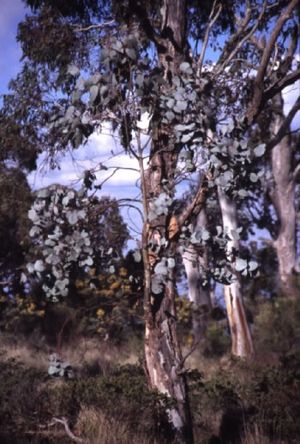Mount Canobolas candlebark facts for kids
Quick facts for kids Mount Canobolas candlebark |
|
|---|---|
 |
|
| Conservation status | |
| Scientific classification | |
| Genus: |
Eucalyptus
|
| Species: |
canobolensis
|
| Synonyms | |
|
Eucalyptus rubida subsp. canobolensis L.A.S.Johnson & K.D.Hill |
|
The Mount Canobolas candlebark (scientific name: Eucalyptus canobolensis) is a special type of tree. It is found only in a small area of New South Wales, Australia. People also call it the silver-leaf candlebark because of its leaves. This tree is quite small and has smooth bark on its trunk and branches. Its adult leaves are dull and shaped like a spear. It has white flowers that grow in groups of three. The fruits look like small cups, bells, or cones. You can only find this unique tree on Mount Canobolas, which is near the town of Orange.
What it Looks Like
The Eucalyptus canobolensis is a tree that usually grows to about 12 meters (40 feet) tall. It has a special woody swelling at its base called a lignotuber. This helps the tree regrow if it gets damaged.
The bark on its trunk and branches is smooth. It can be white, cream, yellowish, or pink, and often looks powdery. Sometimes, the very bottom of the trunk has rough, grey bark.
Young plants and new shoots have leaves arranged in opposite pairs. These leaves are directly attached to the stem (meaning they have no stalk). They are usually between 3 and 11 centimeters (1.2 to 4.3 inches) long and wide.
Older, adult leaves are arranged alternately along the stem. They are shaped like a spear and are dull grey or have a waxy, bluish-grey coating. These leaves are about 6.5 to 19 centimeters (2.6 to 7.5 inches) long and 1.1 to 3.7 centimeters (0.4 to 1.5 inches) wide. Each adult leaf has a stalk, called a petiole, that is about 1.2 to 3.5 centimeters (0.5 to 1.4 inches) long. Both sides of the leaf are usually the same color.
The flower buds grow in groups of three. They are found where the leaves meet the stem (called the axil). These groups of buds are on a flat stalk, called a peduncle, which is about 3 to 9 millimeters (0.1 to 0.4 inches) long. Each individual bud is directly attached to this stalk. When the buds are ready, they are oval to spindle-shaped. They are about 6 millimeters (0.2 inches) long and 4 millimeters (0.2 inches) wide. Each bud has a cone-shaped cap, called an operculum.
This tree has been seen flowering in February, and its flowers are white. The fruit is a woody, cup-shaped, bell-shaped, or cone-shaped capsule. It is about 5 to 6 millimeters (0.2 to 0.24 inches) long and 5 to 8 millimeters (0.2 to 0.3 inches) wide. The fruit is either directly attached to the stem or has a very short stalk. The parts of the fruit that open to release seeds (called valves) stick out beyond the rim.
How it was Named
The Mount Canobolas candlebark was first described in 1991. Two botanists, Lawrie Johnson and Ken Hill, gave it the name Eucalyptus rubida subsp. canobolensis. They published their description in a science journal called Telopea.
Later, in 1998, another botanist named John Hunter decided it was different enough to be its own species. So, he changed its name to E. canobolensis.
The second part of its scientific name, canobolensis, refers to Mount Canobolas. This is the place where the first plant specimen was collected. The ending -ensis is a Latin suffix that means "from a place" or "where something is found."
Where it Lives
The Eucalyptus canobolensis tree is only found on the upper slopes of Mount Canobolas. It grows in a type of forest called subalpine woodland. This means it lives in a cool, high-altitude area, just below where trees stop growing.
Protecting the Tree
The Mount Canobolas candlebark is considered an "endangered" species by the Australian Government. This means it is at a very high risk of disappearing forever. The New South Wales Government also lists it as "vulnerable," meaning it is still at risk.
There are several things that threaten this special tree:
- Weed invasion: Invasive plants, like blackberry (Rubus fruticosus) and Pinus radiata (a type of pine tree), are growing into its habitat. These weeds can outcompete the native eucalyptus for space and resources.
- Building and development: New buildings or other structures can destroy its habitat.
- Forestry work: Activities like logging or tree planting in nearby areas can also harm the trees or their environment.


